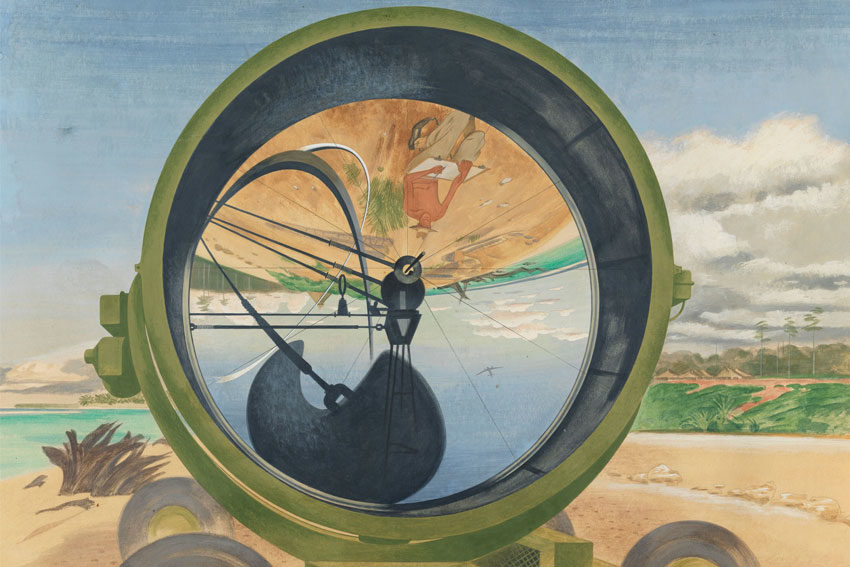Australia's modernist artists bear witness to war

An exploration of how Australian modernist artists responded to the Second World War, Reality in Flames’ diverse collection of work reflects the challenges faced by artists in choosing how war should be interpreted by art.
No explanation is required for Samstag’s tag-teaming of its two current shows For Country, For Nation (reviewed in May TAR) and Reality in Flames. War in all its destructive guises wraps everything that might or should be said in a fog of bitter reflection or a desire to make something good come from it.
In For Country…, the good is measured by telling stories about the self sacrifice of, and contribution made by, Indigenous men and women. It goes further by unpacking the complexity of experiences for Indigenous Australians in war time by documenting the overlapping ‘front lines’ in which non-combatants also saw ‘action’ (Maralinga, bombing of Darwin) as well as the ongoing ‘battle’ for Indigenous rights and equality across the 20th century to the present day.
So the ‘good’ in this instance is built on the belief that war can produce something of lasting value, provided the community takes time to reflect on its lessons and what it confirms about humanity’s aspiration for a better world. Or maybe, as evident in For Country…, that hidden stories that need to be known and acknowledged come to the surface. Because contemporary artists as a whole have become very skillful in dealing with war, particularly the blurred lines between combatants and civilians, and the depersonalised nature of modern warfare (drones controlled by Nevada button pushers), art has adopted remarkable forms and strategies for community engagement.

Wind the clock back, however, to the 1930s, as the prospect of another world war loomed over Australia. Two wars, as it turned out – one in Europe and the other the Pacific. How prepared were Australian artists this time around to interpret war? The Official War Art Scheme, based on similar models in Britain and Canada was reactivated during the Second World War. Ten artists were commissioned as Official War Artists during the First World War. During the course of the Second World War, over 40 official artists were appointed. Alongside this group were independent ‘non-commissioned’ artists such as Albert Tucker and Sidney Nolan who responded to the experience of war in less constrained ways.
Reality in Flames represents a new generation of war artists with a very diverse collection of work. It also reflects the challenges faced by artists in choosing how war should be interpreted by art. The First World War cohort had relatively few challenges. Stylisation of expression was built on tonal figuration. Artists were expected to commemorate valor. Many official portraits of commanding officers were produced. However, some artists such as Arthur Streeton and Will Dyson took themselves off to France to see for themselves. A trend emerged – paintings and sketches in the field, documenting ordinary individuals and their experiences. This trend consolidated in the work of World War Two war artists. There are a number of examples in Reality. Images such as Stella Bowen’s unforgettable group portrait of a bomber crew are a reminder of the weight of responsibility carried by many war artists to memorialise individuals and their experiences. An interesting aspect of the trend is to see how artists like Nora Heysen, Geoff Mainwaring, Roy Hodgkinson and Colin Colahan invested their ‘ordinary folk’ with a touch of gravitas to draw attention to the heroic character of their deeds and responsibilities.

World War One ‘heat of battle’ scenes were rare but the aftermath of the war saw the production of George Lambert’s Anzac, the landing 1915 and The charge of the 3rd Light Horse Brigade at the Nek, 7 August 1915 both commissioned in 1920 by the War Memorial. That Lambert had visited and sketched the Gallipoli area after the war enabled him to capture the dreadful nature of ‘charge at machine guns’ conflict and the spectre of the so many about to be swallowed by the red earth. Ivor Hele’s painting of troops cleaning out Japanese fox holes emerges from the Second World War cohort as a worthy successor. It deserved to be scaled up as a monumental and gut-churning expression of madness and fury. Roger Kemp’s War conception, 1941–42 comes close to this in its barely contained, gestural rage at a looming, apocalyptic future. Yosl Bergner’s searing capture of refugees and the have-nots of wartime Melbourne command respect to the present day. But in terms of emotional, cross-generational consignment Albert Tucker’s Images of Modern Evil (inspired in part by the scarifying experience of working at the Heidelberg Military Hospital) has an in-your-face capacity to speak directly to contemporary audiences.
As a counterweight to these expressions of white-hot rage, images of incarceration, such as Howard Taylor’s POW camp, Germany (1942- 43) and Bernard Slawik’s small pencil sketches of Nazi atrocities make for sombre viewing. Such considerations aside, perhaps the alternative interest in this collection of work, made almost 80 years ago, is the predicament of so many younger Australian artists, grappling to come to terms with half-understood modernism, while bending it to the cause of victory.
Reality in Flames: Modern Australian Art and the Second World War
Samstag Museum of Art
Until Friday, July 19
unisa.edu.au/samstagmuseum
Header image:
Eric Thake, Kamiri searchlight, 1945, gouache, pencil on paper 55.5 x 78.2 cm, ART26787